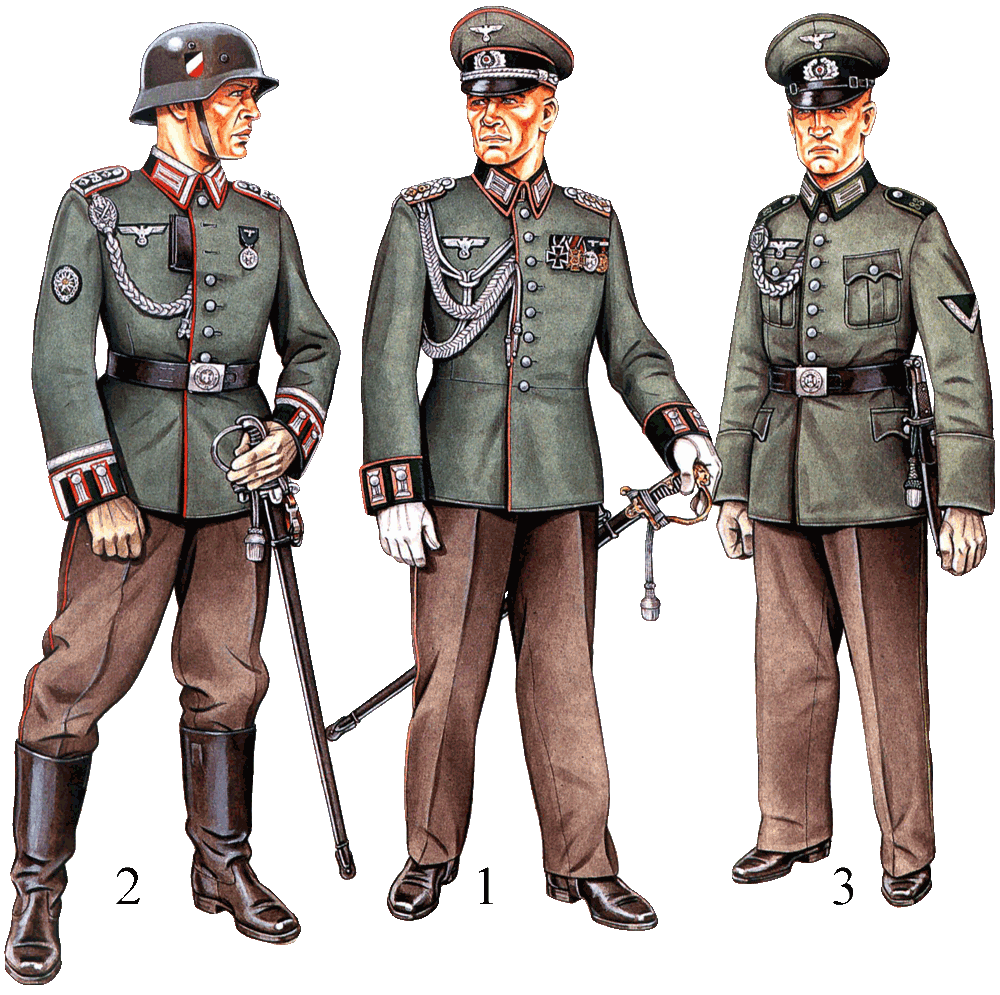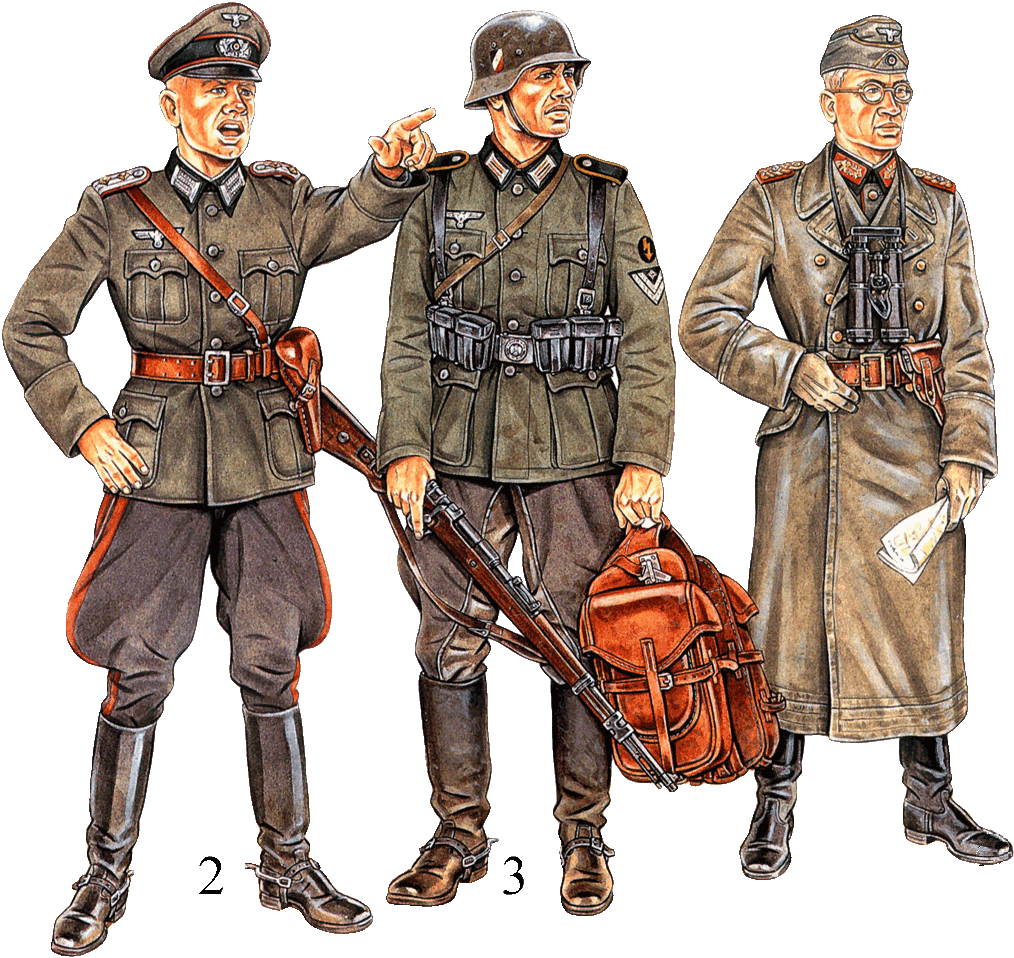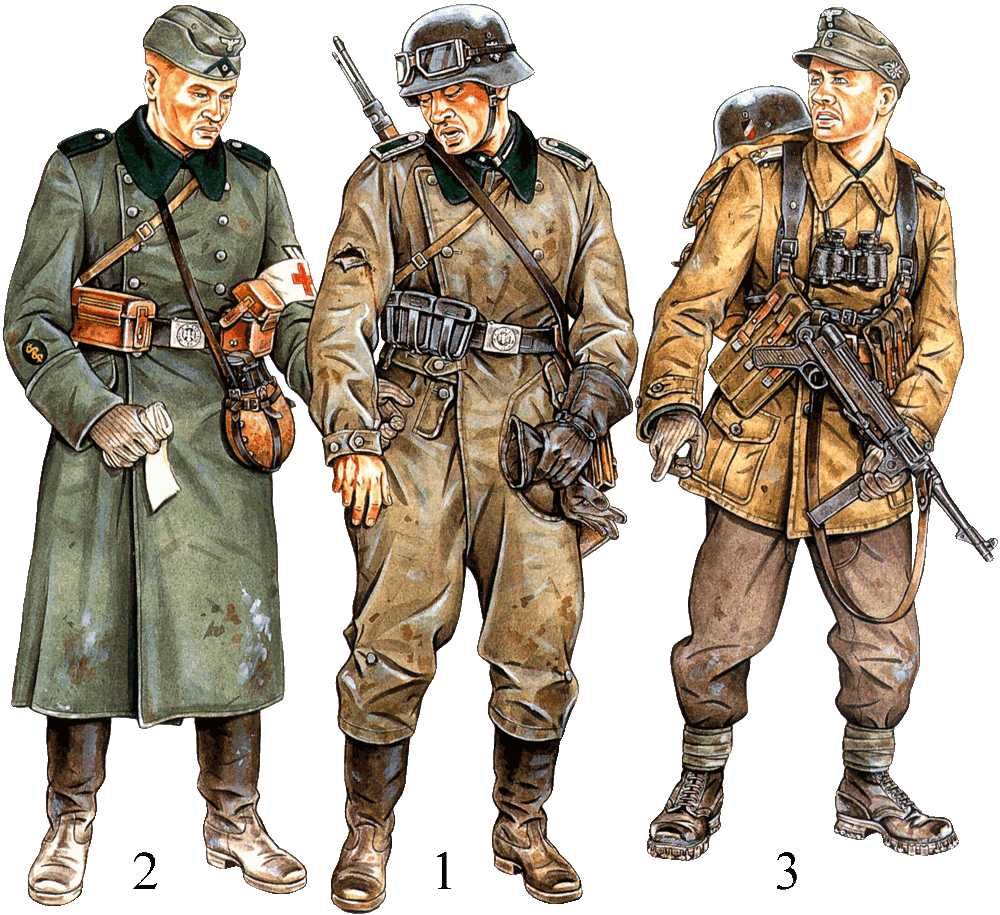
NIGEL THOMAS, colour plates by STEPHEN ANDREW
GERMAN ARMY 1939-1945. BLITZKRIEG
A German soldier's branch of service was indicated by a branch colour, worn on the collar and shoulder-board and shoulder-straps, and as cap, tunic and trouser pipings. The system of branch colours, a development of the regimental facing-colours in the Reichsheer of the German Empire, was established on 22 December 1920, continued, with comparatively few changes, until 9 May 1945.

An Unteroffizier, in M1935 field uniform, threatens French prisoners with his Karabiner 98k in northern France, May 1940. He wears a single set of ammunition-pouches and carries standard 6 × 30 binoculars, suggesting he is a section leader, and is sporting a civilian scarf against regulations. (ECPA)
Branch insignia comprised a symbol, or a letter in Gothic script, worn by certain specialised troops within a branch, above the unit insignia - an Arabic or Roman numeral, or, in the case of Army Schools, Gothic letter(s). There was a wide variety of such insignia, and so only a selection of the principal combat units is covered here.
Such precise unit identification aided personal and unit morale, but jeopardised field security and so, from l September 1939, troops in the Field Army were ordered to remove or conceal their unit insignia. Many troops covered the unit insignia on their field shoulder-boards and shoulder-straps with a feldgrau (black for Panzer units) shoulder-slide or wore their shoulder-boards/straps reversed. The branch insignia, which was less specific, was usually retained. Unit insignia could still be worn by the Replacement Army or by Field Army troops on leave in Germany. In fact, unit insignia was often worn in the field in defiance of these regulations. On 24 January 1940 3cm wide feldgrau shoulder-slides with branch and unit insignia in branch colour chain-stitch were introduced for NCOs and other ranks, but senior NCOs often continued to wear their white aluminium insignia. Insignia on dress uniforms not worn in the field, was unaffected.
The pre-war system of numerals on the shoulder-strap buttons of other ranks in regiments - blank for regimental staff, I-III for battalion staff; 1-14 for constituent companies - was replaced in wartime by standard blank buttons.
Certain specialised or elite units, or a few units carrying the traditions of regiments of the Imperial Reichsheer, wore special insignia, usually extra cap badges, worn between the eagle and swastika and the cockade, or, in a growing trend borrowed from the paramilitary Sturmabteilung, as sleeve-titles.
Fable 4 gives a list of the principal units in existence from 1 September 1939 to 25 June 1940, with their branch colours, branch insignia, unit and special insignia. Existence of these units before or after these dates is not excluded, nor did all units necessarily see combat at this time.
From 2 May 1939 all ranks of mountain divisions wore insignia incorporating the alpine flower, the edelweiss, originally worn by German and Austro-Hungarian units in the First World War. A white aluminium edelweiss with gilt stamens was worn above the cockade on the peaked cap. A white aluminium edelweiss with a stem, two leaves and gilt stamens (war-time production used grey aluminium with yellow stamens) was worn on the left side of the mountain cap, Austrian personnel often adding a bluish dark-green facing-cloth backing. A machine-woven white edelweiss with yellow stamens, light-green stem and leaves within a mouse-grey rope wreath on a dark-green facing-cloth oval (after May 1940 feldgrau), was worn on the right upper sleeve of tunics and greatcoats.
Six infantry battalions also wore the light-green J#228;ager branch colour to preserve the light infantry tradition, but they remained infantry battalions - it was not until 28 June 1942 that specialised J#228;ager units were raised.
Two commemorative matt aluminium badges were worn by all ranks in certain regiments between the eagle and cockade of the service cap and, unofficially, on the field cap. From 25 February 1938 the 17th Infantry Regiment wore the Brunswick skull and crossbones to commemorate the Imperial 92nd Infantry Regiment. From 21 June 1937 the 3rd Motorcycle Reconnaissance Battalion, and from 26 August 1939 the 179th Mounted, 33rd, 34th and 36th Divisional Reconnaissance Battalions, wore the dragoon eagle, also called the 'Schwedt eagle' to commemorate the Imperial 2nd Dragoon Regiment.

Northern France, May 1940. A section LMG team in field uniform with the section leader (2nd left) watching for the enemy. The LMG34 is mounted on a tripod for use as a heavy machine gun. Note the machine gunner's improvised assault-pack, consisting of an M1931 mess-tin tied to the back of his belt with belt supporting-straps. (Brian Davis Collection)
The Groβdeutschland Infantry Regiment was formed on 12 June 1939 from the Berlin Guard Regiment (Wachregiment Berlin) and developed into an elite unit. Defying field security, their insignia was worn throughout the war. The GD shoulder-board/strap monogram (introduced 20 June 1939) and a woven aluminium thread Groβdeutschland and edging was worn on a bluish dark-green cuff title (introduced 20 June 1939). This was superseded for a short time in summer 1940 by a silver-grey woven Gothic-script Inf.Rgt Groβdeutschland, which was worn on the right cuff of all uniforms. Groβdeutschland personnel assigned to Hitler's field HQ, the Filhrerbegleitbataillon, wore a golden-yellow machine-embroidered, machine-woven or hand-embroidered (also found in silver-grey thread) Gothic-script Führer-Hauptquartier and edging on a black wool sleeve title.
From 21 June 1939 the Armoured and Signals Instruction battalions wore a gold machine-woven 1936 Spanien 1939and edging on a madder-red cloth cuff title on the left cuff to commemorate their service in Gruppe Imker during the Spanish Civil War. From 16 August 1938 personnel of the newly formed war correspondent companies wore a machine- or hand-embroidered aluminium Gothic-script Propagandakompanie on a plain black sleeve-title on the right cuff.
The Military Police was formed on mobilisation on 26 August 1939 from 8,000 German Gendarmerie. Motorised three-company battalions were assigned to field armies, allocating a 33-man Trupp to an infantry division, a 47-man Trupp to an armoured or motorised division and a 32-man Trupp to a sub-district. Initially MPs wore their M1936 Gendarmerie uniforms with Army shoulderboards/straps and a medium-green armband with orange-yellow machine-embroidered Feld-Gendarmerie. This was replaced in early 1940 by Army uniform with, on the left upper-sleeve the Police sovereignty-badge - a machine-woven or embroidered orange eagle and black swastika in an orange wreath (officers wore hand-embroidered aluminium thread) on feldgrau backing. On the left cuff was a machine-woven aluminium Feldgendarmerie on a brown sleeve-title edged in aluminium yarn, later machine-embroidered in silver-grey yarn. When on duty MPs wore the matt aluminium gorget with an eagle and Feldgendarmerie in aluminium on a dark-grey scroll. Traffic Control personnel wore the MP uniform without these three insignia, wearing a black cotton woven Verkehrs-Aufsicht on a salmon-coloured armband on the left upper sleeve. The Army Patrol Service, equivalent to British Regimental Police, wore the obsolete M1920 matt aluminium wire adjutant's lanyard on the field tunic and field greatcoat.
Music Directors wore staff-pattern bright gold, or matt gold, Kolben collar and cuff-patches, and from 12 April 1938 all Bandmaster Officers wore special bright aluminium and bright red silk aiguillettes on formal uniforms. On dress and field tunics regimental bandsmen wore M1935 'swallow's-nest wings' made of bright aluminium NCO braid and branch colour facing-cloth, introduced 10 September 1935, drum-majors adding aluminium fringes. Other specialist badges will be covered in Volume 2.
On 16 March 1936 the Wehrmacht Long Service Decoration was instituted as a cornflower-blue ribbon with, for the Army, a silver or gold eagle and swastika. Four or 12 years' service merited a silver or gold medal, 18 or 25 years, a silver or gold cross, and, from 10 March 1939, 40 years a gold cross with gold oakleaves on the ribbon.
Five pre-war campaign medals were awarded. On 1 May 1938, the matt silver '13 March 1938 Commemoration Medal', usually known as the 'Anschluss Medal', with a red, white and black ribbon, was issued to troops participating in the occupation of Austria. On 18 October 1938 the bronze '1 October 1938 Commemoration Medal' with a black and red ribbon, was issued for the occupation of Sudetenland, and on 15 March 1939, of Bohemia-Moravia. The bronze '13 March 1938 Commemoration Medal' with a red, white and green ribbon, was issued on 1 May 1939 for the occupation of Memel District. On 14 April 1939 the bronze, silver or gold Spanish Cross with swords and, the highest award, with diamonds, was instituted for service in the Spanish Civil War; it was worn as a pin-back cross on the right breast-pocket. Finally, on 2 August 1939 the bronze 'German Defensive Wall Medal' with a white and yellowish-brown ribbon was instituted for service building the Westwall - the 'Siegfried Line' fortifications on Germany's western frontier.
The most common military bravery award for courage in the field was the Iron Cross, reconstituted 1 September 1939 as a black and silver cross with a red, white and black ribbon. The Iron Cross 2nd Class was worn as a ribbon attached to the second button-hole of the field tunic, or as a small silver eagle, swastika and 1939 to the black and white 1914 ribbon. The Iron Cross 1st Class was a medal pinned to the left breast-pocket or as a larger eagle, above the 1914 cross. The Knight's Cross, instituted 1 September 1939, was worn from a ribbon around the neck. The War Merit Cross, a bronze cross with a red, white and black ribbon, was worn in 2nd Class as a ribbon, or as 1st Class pinned to the left breast-pocket. It was awarded for merit or bravery in places other than the front line.

Mountain troops in M1935 field uniform and round-lens general purpose goggles, cross a Norwegen fjord in eight-man rubber dinghies in June 1940. The relaxed scenario and lack of field equipment indicate that hostilities have ceased. (Brian Davis Collection)
On 22 May 1939 an oval aluminium pin-back wound-badge for the left breast-pocket was instituted for service in the Spanish Civil War, featuring a swastika and Spanish helmet on crossed swords within a wreath, manufactured in three versions - black, for one or two wounds; silver, for three or four wounds; and gold, for five or more, although not surprisingly, the gold was never awarded. On l September 1939 the badge, now with a German helmet, was introduced for the Second World War.
Four pin-back combat qualification-badges could be worn on the left breast pocket. The Condor Legion Tank Combat Badge, a bronze or white aluminium skull, tank and wreath, was instituted 10 July 1939. The Infantry Assault Badge, a white aluminium eagle, rifle and wreath, was issued from 20 December 1939, with a bronze version for Motorised Infantry from 1 June 1940. The Tank Combat Badge, a white aluminium eagle, tank and wreath, was instituted 20 December 1939 for tank-crews and medical support personnel, followed on 1 June 1940 by a bronze version for armoured car crews and medical personnel. The Engineers' Assault Badge, later the General Assault Badge, a white aluminium eagle, crossed bayonet and grenade and wreath, was instituted 1 June 1940, initially for assault engineers.
The Narvik Shield was awarded on 19 August 1940 for personnel who fought in Norway at the Battle of Narvik, 9 April - 9 June 1940. It was a grey aluminium eagle above Narvik and a crossed edelweiss, propeller and anchor, worn on a feldgrau oval on the upper left sleeve.
Army personnel could also wear First World War medals and Nazi awards, such as the SA Defence Badge.

A1: Oberstleutnant, Panzerregiment 8, full ceremonial uniform, Böblingen, Germany, July 1939
This battalion commander of Panzerregiment 8, which later fought in Poland, Luxembourg and France with 10.Panzerdivision, wears the regulation M1935 full ceremonial uniform with 'Flower Wars' and Nazi decorations, and the Army Long Service medal. The officers' M1935 sword-knot, made of feldgrau leather with an aluminium ball, introduced 7 November 1935, hangs from his privately purchased officers' sword, usually preferred to the M1922 issue sword introduced 17 February 1922.
A2: Hauptwachtmeister, Gebirgsartillerieregiment 79, parade uniform, Garmisch-Partenkirchen, Germany, July 1939
As the ranking artillery battery NCO, the Hauptwachtmeister was a formidable personality, wearing the double NCO cuff-braids of his appointment and his report-book stuffed into his dress or field tunic. He wears the marksman's lanyard, with artillery shells to denote the awards, and carries the officers' sword and sword-knot. As a member of the elite 1st Mountain Division, which later fought in Poland and France, he wears the Edelweiss arm-badge.
A3: Fahnenjunker-Gefreiter, III (Jäg)/Infanterieregiment 83, walking-out uniform, Hirschberg, Germany, July 1939
This conscript, accepted for officer-training, wears the other ranks' field tunic with officers' cuffs, branch colour pipings and dress-quality insignia as an alternative to the Waffenrock. The junior NCO bayonet-knot tied to the bayonet-frog is the only indication of his status.

B1: Generalleutnant, 14.Infanteriedivision, field uniform, Lublin, Poland, September 1939.
The commander of 14th Infantry Division, which fought in southern Poland with the 10th Army, and later in Belgium with the 6th Army, wears the leather greatcoat popular with general-officers over his field tunic. He wears the M1938 officers' field cap, carries the Walther PPK 7.65mm pistol on his belt, and has powerful 10 × 50 Zeiss binoculars.
B2: Hauptmann i.G., 14.Infanteriedivision, field uniform, Lublin, Poland, September 1939
General Staff officers were ranked Generaloberst - Hauptmann im Generalstab (Captain). This officer, the third divisional staff officer, the '1c' (Intelligence Officer), wears field-quality staff Kolben collar-patches and breech stripes, and the M1934 'old style' field cap. He carries a P08 Luger pistol in a hard shell holster and wears the cross-belt, which was abolished after the Polish campaign.
B3: Stabsgefreiter, Reiterregiment 2, field uniform, Rozan, Poland, September 1939
This cavalryman, a Reichswehr veteran promoted to Stabsgefreiter before the rank was abolished on 1 October 1934, wears the cavalry field uniform with reinforced breeches and riding boots. The 'lightning' arm badge indicates that he is a signalman in the regimental signals platoon. He carries the M1934 saddlebags for mounted personnel introduced 7 May 1934, and the M1934 Karabiner 98k, the standard German rifle. His regiment fought in Poland and France with 1st Cavalry Division.

A section of the Groβdeutschland Regiment in M1935 guard uniform, France, June 1940. Members of this élite German infantry regiment wore the regimental cuff-title and shoulder-strap monogram on all uniforms, even in the field. Note the marksman's lanyards, as worn on this uniform, and the soldierly parade ground bearing of the troops. (ECPA)

C1: Unteroffizier, Infanterieregiment 96, field uniform, Chelmo, Poland, September 1939
As a section leader this NCO is wearing the standard field equipment with a flashlight and 6 × 30 issue binoculars. He carries the Karabiner 98k rifle - section leaders were not normally issued submachine guns until 1941 - and a M1924 stick-grenade, known as the 'potato masher'. He has reversed his shoulder-straps to conceal his unit insignia and tied a thick rubber band to his helmet to secure his camouflage foliage. His regiment fought in Poland, Belgium and France with the 32nd Infantry Division. In the foreground lies a discarded Polish M1931 helmet.
C2: Obergefreiter, Infanterieregiment 96, field uniform, Chelmo, Poland, September 1939
This Landser ('German soldier') is the Section First Gunner, typically an Obergefreiter, with the 7.92mm IMG34 general-purpose light machine gun. He carries a machine gunner's field equipment: a P38 pistol in a hard-shell holster for close combat and an M34 spares pouch, a gas cape pouch across his chest in the prescribed manner, and two 50-round belts of 7.92 × 57 ammunition.
C3: Schütze, Infanterieregiment 96, field uniform, Chelmo, Poland, September 1939
The bulky M1934 backpack, introduced 10 February 1934, and the M1939, introduced 18 April 1939, was normally left with the unit's transport column, allowing infantrymen to fight in light order. The bayonet and bayonet-frog was strapped to the entrenching-tool on the left back hip, the mess-kit, camouflage shelter-quarter and gas mask canister worn on the lower back, and the bread-bag and canteen on the right back hip. The private carries a Karabiner 98k and has tied bread-bag straps to his helmet to fix camouflage foliage. In defiance of regulations he is displaying his regimental number on his shoulder-straps.

We have much more interesting information on this site.
Click MENU to check it out!
∎ cartalana.com© 2009-2025 ∎ mailto: cartalana@cartalana.com